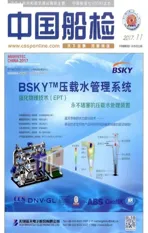Enlightenment brought by the ahead-of-schedule implementation of Yangtze River Delta ECA
2017-12-14ByLiuXiao
By LiuXiao
Enlightenment brought by the ahead-of-schedule implementation of Yangtze River Delta ECA
By LiuXiao
From November 2015, the Ministry of Transport published the Implementation Plan of Ship Emission Control Area in the Pearl River Delta, Yangtze River Delta and Waters around Bohai Sea (Beijing-Tianjin-Hebei) (hereinafter referred to as the“Implementation Plan”). By September 1 this year,the regulation that “vessels should use fuel with sulfur content no more than 0.5% m/m when berthing at all ports within ECA” was implemented 4 months in advance.
A few months ago, the state environmental protection department issued a set of monitoring statistics on air quality across the Yangtze River Delta. Data shows that compared with previous years, the air quality across the Yangtze River Delta region has been significantly improved from April 2016. According to the introduction of Shanghai Composite Port Management Committee, it is the result of the fi rst phase application of the ECA in the Yangtze River Delta waters. Therefore, the second phase of the “Implementation Plan” was brought four months ahead of the original plan, and was implemented on September 1st this year
In facing the current situation in which vessels need to use fuel with sulfur content no more than 0.5% m/m when berthing at all domestic ECA ports, interviewees said that SO2 emission may be reduced by 86%compared with that of the traditional fuel which contains sulfur of 3.6%, shipping companies have to pay more in fuel costs.
So which way is more cost-effective in dealing with the ship exhaust gas pollution under the current strict rules? During the interview, the experts demonstrated to reporters a study on comparison of an agency's use of alternative fuels for LNG and the use of flue gas desulphurization technology. The fi nal conclusion of the report induced from formulaic calculations contained in the economic chapter is that whether LNG can be used as a cost-ef fi cient alternative fuel depends mainly on the following two points. First is the price difference with HFO; and second is the proportion of emission-controlled areas. The greater the proportion of price differences and emission control areas, the more obvious the economic advantages of FGD technology. European and American ship owners currently adopt some of the programs. The EU has implemented strict and extensive controls on ship emissions by delineating the Emissions Control Areas and EU legislation.
“As far as I know, in order to better help ship owners to fulfill their obligations, the relevant departments have been considering the introduction of the same standard low-sulfur oil subsidy and exemption policies. These policies and measures will not only play an important role in limiting sulfur emission, but bene fi t relevant ship owners. ”“During the interview, an expert commented outspokenly that ‘’the subsidy policy is temporary which will not continue. In order to completely limit the ship sulfur emission, shipping companies need to step up efforts to take advantage of technology updates, shore power, etc. At the same time, promote the technological progress of desulfurization equipment. ”
